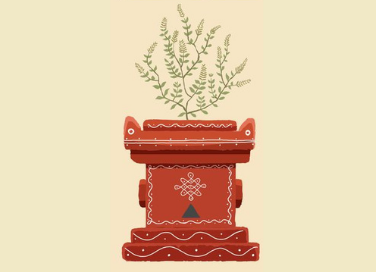The tangy fruit, lemon, finds its application in many culinary and non-culinary uses. Not only is it used extensively to flavour food, but it also has value as an anti-bacterial. Here are a few important uses of lemon.

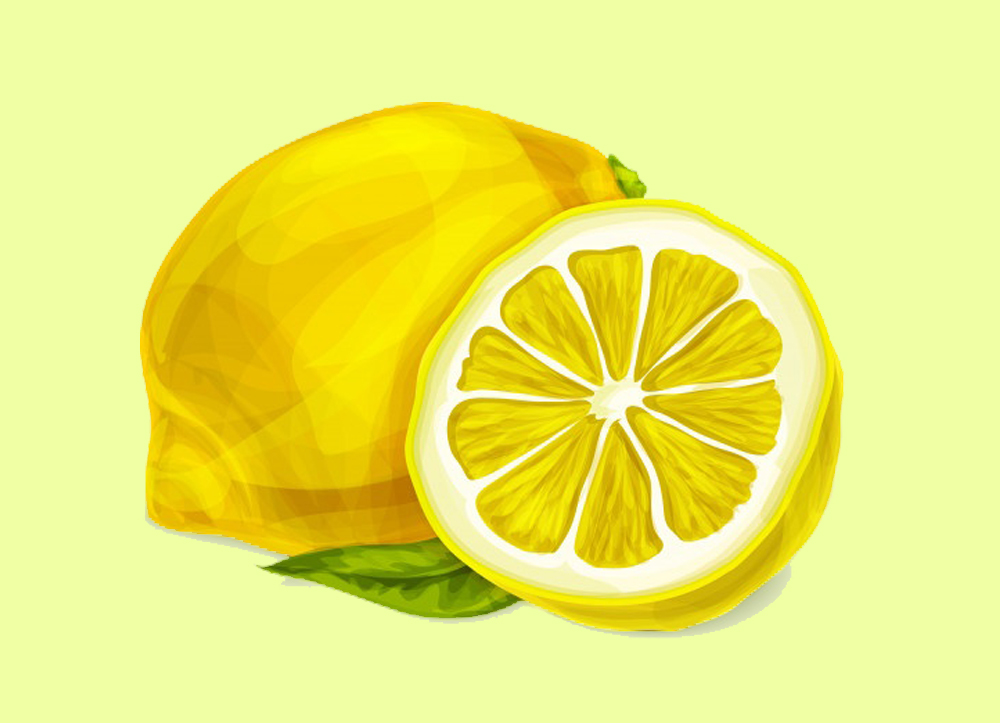
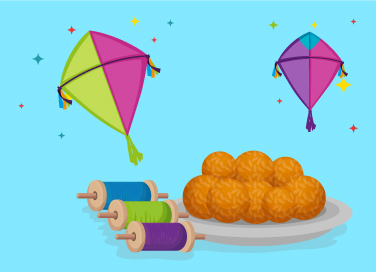
By Kayva Gokhale
Tilgul is a major tradition of Makar Sankranti. ‘Til‘, meaning sesame seeds and ‘gul‘ meaning jaggery, make up this delicious but simple sweet treat. Extremely popular in Maharashtra, this sweet is made by mixing jaggery and sesame seeds, sometimes along with other ingredients like coconut or dry fruits, and making small laddoos or chikki from it.
Sesame seeds are very nutritious, containing zinc, copper, iron and other vitamins, which are great for building good immunity. Since wintertime brings with it cases of cough, cold and flu, eating sesame seeds is a way to keep the body healthy. Furthermore, jaggery is known to produce heat inside the body, another plus point in cold climes. Thus, tilgul is not only a tasty snack, but also a healthy and nutritious addition to your winter diet.
Sesame seeds are mentioned many times in our ancient texts and have some interesting beliefs associated with them. According to some legends, these seeds were blessed by Yama, the God of Death, and can therefore grant immortality. This is also why black sesame seeds are said to be the food of departed souls. Some others believe that the seeds were created when drops of Vishnu’s sweat solidified, and that they contain the essence of the divine in them.
While tilgul is prepared and eaten throughout winter, it is specifically made for the festival of Makar Sankranti, which falls in mid-January. On Sankranti, families and friends exchange tilgul sweets and say to each other,
“Tilgul kha, goad goad bola”, meaning “Have sweet tilgul and speak sweet words.”
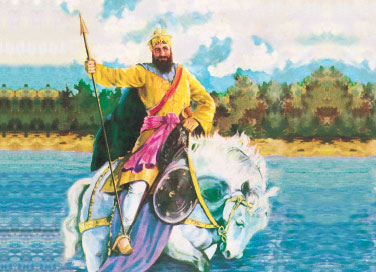
By Kayva Gokhale
Guru Gobind Singh, the tenth Sikh Guru, helped the Sikhs transform into disciplined volunteers prepared to fight for their faith, by establishing the Khalsa. On the first day of Baisakhi in 1699, he asked his community to assemble and demanded a human head.
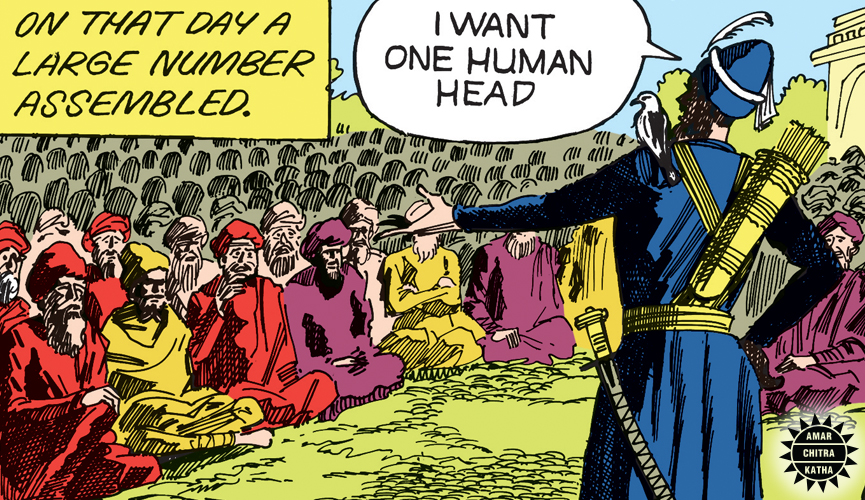
While initially there was a stunned silence, soon a young man stood up and offered his head to the Guru. Guru Gobind Singh then led the man into a tent and came out, his sword stained with blood. Once again, he asked for a human head and once again, a young man volunteered. He too went into the tent, after which the Guru came out with fresh blood on his sword. This happened five times.
Guru Gobind then revealed that all five of the volunteers were, in fact, alive and well. He was simply testing the faith of his community. These brave volunteers were named his ‘Panj Pyare’ or ‘The Beloved Five’. Guru Gobind Singh then established a new community – The Khalsa, or the Pure.
The Khalsa was established by the Guru boiling water in an iron vessel and stirring in sugar with a double-edged dagger. This water or ‘Amrit’ was then given to the Panj Pyare, and the Guru anointed them as ‘Singhs’ or lions.
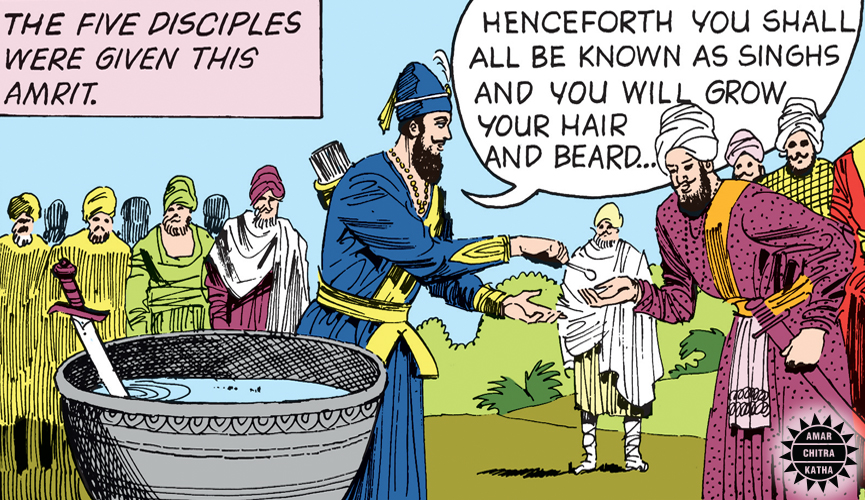
He also laid down the rules of the Khalsa and explained the five emblems of the community. The emblems were –
Guru Gobind Singh declared that the Khalsa are the ‘Pure’ and hence they could never harm the weak or molest a woman and would always regard all men as their brothers. The men in the Khalsa then baptised the Guru, changing his name from Gobind Rai to Gobind Singh, signifying that the Guru is of the Khalsa as much as the Khalsa is of the Guru.
The establishment of the Khalsa was a significant moment in the history of Sikhism and Punjab. Today, Sikhs celebrate Guru Gobind Singh and his teachings for the Khalsa, on Baisakhi every year.
Read more about the life of Guru Gobind in our title Guru Gobind Singh, now available on the ACK Comics app, Kindle, Flipkart, Amazon and other major e-tailers.
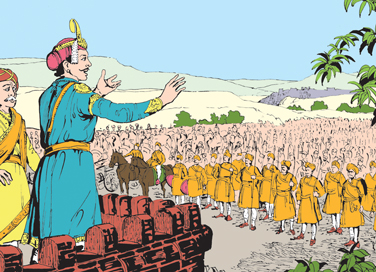
By Srinidhi Murthy
Krishnadeva Raya was the King of Vijayanagara from 1509 to 1529. During his reign, Vijayanagara reached the zenith of its prosperity. He won many important battles and defeated the Sultans of Bijapur and Golconda. He was considered one of the most powerful rulers of his time when the north witnessed the rise of the Mughal Emperor Babur. Read on to know more about his life.
In 1509, Vira Narasimha, the King of Vijayanagara, fell seriously ill. Due to the severity of his condition, there was much discussion about succession after his death. People wondered whether the throne would go to Vira Narasimha’s young son or his brother, Krishnadeva Raya. Vira Narasimha desperately wanted his son to succeed him. The king, blinded by affection, saw his younger brother as a threat to his son. Taking drastic measures, he ordered his trusted minister Timmarasu (known fondly as ‘Appaji’) to kill Krishnadeva Raya to secure the throne for his young son. Appaji was shocked at this order, since he had witnessed how devoted Krishnadeva Raya was to his elder brother.
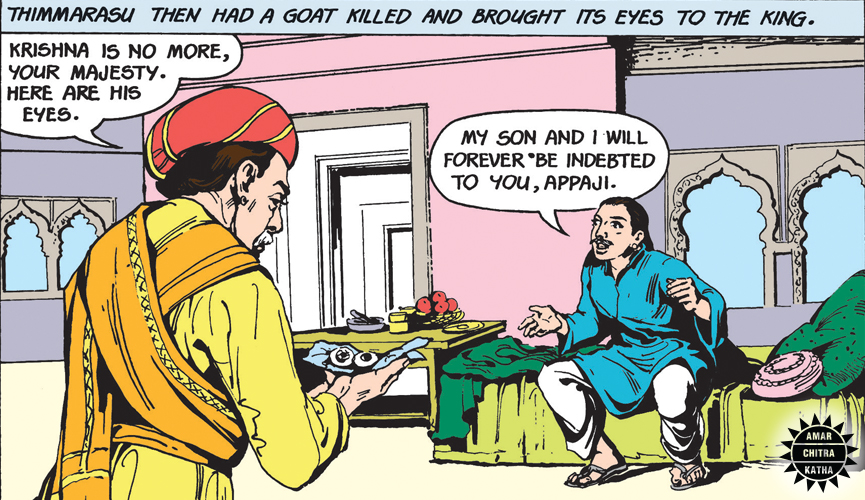
In an attempt to save his life, Appaji arranged for Krishnadeva Raya to be exiled in secret. Appaji then brought Vira Narasimha the eyes of a goat as proof of his younger brother’s death.
The news of Vira Narasimha’s illness and the disappearance of Krishnadeva Raya reached Mahmood Shah, the Bahmani king. He decided to take advantage of this opportunity and planned an attack on Vijayanagara. Upon hearing this, Vira Narasimha panicked. He realized that his son was too young to defend the kingdom and he, in his foolishness, had ordered the death of his brother without thinking about the grave consequences. But soon, Appaji revealed the truth. Vira Narasimha was overjoyed. He immediately summoned Krishnadeva Raya to apologise for his actions. Krishnadeva Raya was crowned King of Vijayanagara after the death of Vira Narasimha, with the full support of the council. Mahmood Shah retreated after learning about the coronation.
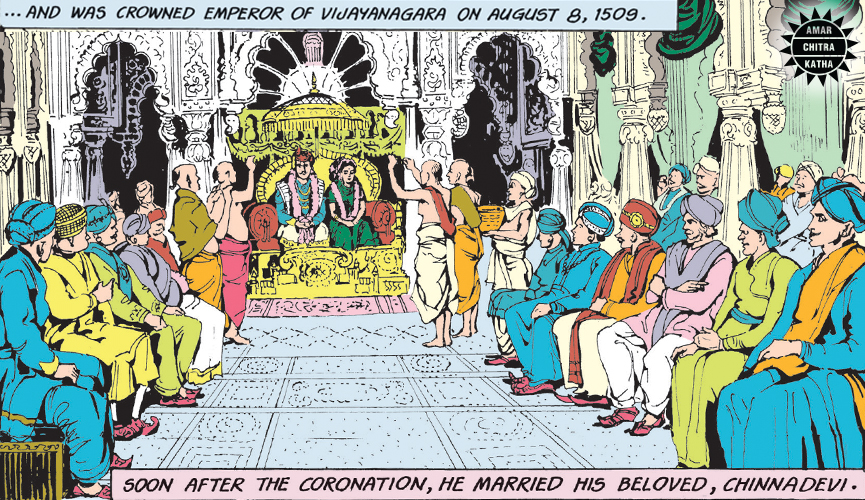
After ascending the throne, Krishnadeva Raya decided to attack his enemies, Pratapa Rudra of Kalinga and Adil Khan of Bijapur, to secure the stability of Vijayanagara. Pratapa Rudra planned his defence well, but Krishnadeva Raya’s army was ferocious. After capturing the forts of Udayagiri and Kondavidu, Krishnadeva Raya marched on to Potanur. There, Appaji found out that as long as Pratapa Rudra had the support of his sixteen loyal chieftains, Krishnadeva Raya would not be victorious. With the help of his secret agents, Appaji created friction and doubt in the mind of Pratapa Rudra about the loyalty of these chieftains. When the chieftains learnt about the king’s suspicions, they quietly slipped away to save themselves from the wrath of Pratapa Rudra. With no barriers to stop him, Krishnadeva Raya triumphantly marched into the city. Pratapa Rudra, now helpless, was unable to stop him from entering the city. Later, peace was declared between the kingdoms of Vijayanagara and Kalinga with Krishnadeva Raya marrying Jaganmohini, the Princess of Kalinga.
Krishnadeva Raya soon turned his attention towards Bijapur. After the death of Mahmood Shah, the Bahmani King Ismail Adil Khan, had declared himself as the independent ruler of Bijapur. He had imprisoned the sons of Mahmood Shah and seized Raichur, when Krishnadeva Raya was busy with the battle of Kalinga. On his return, Krishnadeva Raya and his army laid siege to Raichur. Even though Adil Khan had the upper hand initially, the soldiers of Vijayanagara fought fearlessly. Adil Khan and his army had to retreat. When Krishnadeva Raya entered Raichur, Adil Khan sent his ambassador to request Krishnadeva Raya to give him back his territories. Krishnadeva Raya promised to return his territories, with the condition of the personal surrender of Adil Khan. When Adil Khan didn’t turn up, Krishnadeva Raya captured Gulbarga and made the first son of Mahmood Shah, the Bahmani King of Deccan.
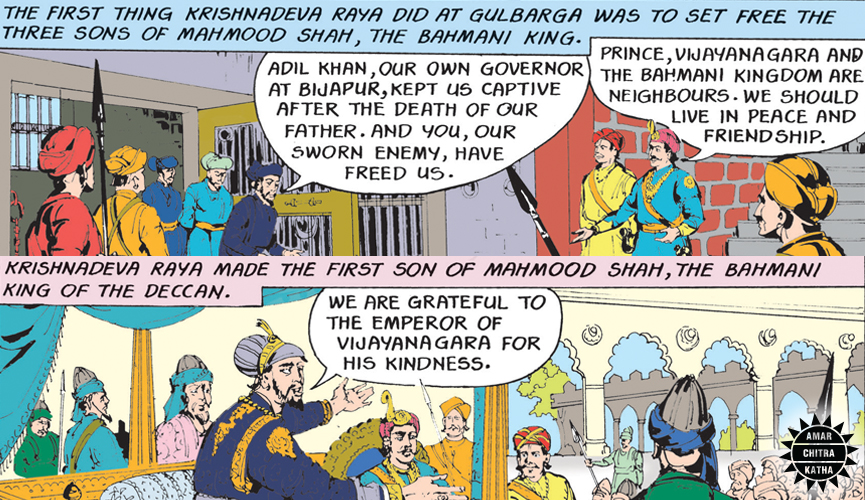
In the span of twenty years, Krishnadeva Raya defeated his enemies and made Vijayanagara a strong and prosperous kingdom.
Read more about Krishnadeva Raya in our title Krishnadeva Raya. Now available on the ACK Comics App, Kindle, Amazon, Flipkart, and other major e-tailers.
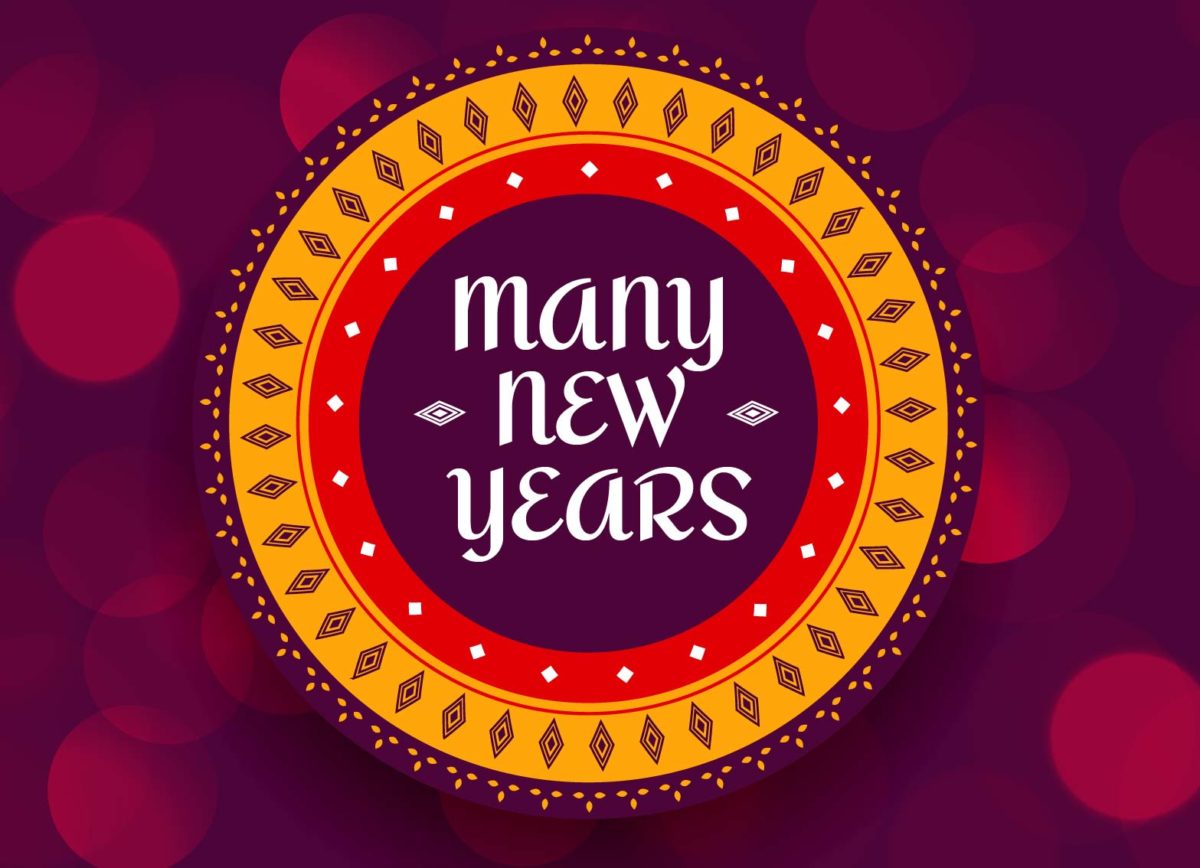
As per the Gregorian calendar, New Year’s Day is celebrated on the 1st of January every year. However, in India, this is not the only New Year we celebrate! Different regions and religions in our country celebrate New Year at different times of the year, and it usually coincides with the beginning of the harvest season. Here are some of the most popular Indian New Year Festivals that we look forward to this year.
Celebrated in: Punjab
Indian Calendar Day: First day of Vaisakha as per the Hindu lunisolar calendar
Gregorian Calendar Date: 14th or 15th April
Other names: Vaisakhi
Other significance: The day is very important for the Sikh community as it also marks the birth of the Khalsa order established by Guru Gobind Singh. Historically, Baisakhi has been significant, as this is the day that Ranjit Singh was proclaimed the Maharaja of the Sikh empire in 1801. This is also the day on which the Jallianwala Bagh Massacre took place in 1919.
Celebrations: On this day, Sikhs celebrate by attending devotional kirtans, visiting Gurudwaras and raising the Nishan Sahib flag. Baisakhi is a day of joy, to be spent socialising with family and friends, feasting on special festival foods.
Celebrated by: Kashmiri Hindus
Indian Calendar Day: First day of the fortnight after Amavasya (new moon), in the month of Chaitra
Gregorian Calendar Date: March or April
Celebrations: The night before, Kashmiris prepare a plate or thali filled with rice, curd, bread, walnuts, silver coins, a pen and inkpot and an astrological almanac of the new year. This plate is the first thing that is viewed on New Year’s Day, in the early hours of the morning. This day is also dedicated to Goddess Sharika and families visit temples to offer prayers and turmeric rice to the deity, as an auspicious start to the new year.
Celebrated by: Sindhi community
Indian Calendar Day: First day of the Sindhi month of Chet (Chaitra)
Gregorian Calendar Date: Late March or early April
Other significance: Apart from being the first day of a new year, Cheti Chand also marks the birth of Uderolal or Jhulelal, an important deity of the Sindhi community.
Celebrations: This day is celebrated with the organisation of fairs, feasts and processions honouring Jhulelal. Some Sindhis also prepare Baharana Sahib, which consists of a lamp, some sugar, cardamom, fruits, flowers, kalash, coconut, and a statue of Lord Jhulelal. This Baharana Sahib is meant to be seen as a representation of Jhulelal and is taken to a lake or river.
Celebrated in: Maharashtra, Konkan, Daman, Diu, parts of Goa
Indian Calendar Day: First day of Chaitra as per the Hindu lunisolar calendar
Gregorian Calendar Date: Mid April
Other names: Samsara Padavo
Other significance: Gudhi Padwa celebrates the arrival of the spring and the reaping of the Rabi crops. It is also linked to the mythical day on which Lord Brahma created the universe.
Celebrations: On this day, Maharashtrians erect Gudhis and perform pujas or participate in processions. ‘Gudhi’ refers to the staff or flag, which is wrapped with garlands, mango and neem leaves and has an upturned copper pot on top. The Gudhi symbolises different things such as the victory of King Shalivahana, the Brahmadhvaj mentioned in the Brahma Purana, and is also used to ward off evil and invite prosperity into the home. This day is meant to be celebrated with family members, exchanging sweets, wearing new clothes and cooking special delicacies, like Srikhanda Puri or Puran Poli.
Celebrated in: Kerala, Tulu Nadu in Karnataka
Indian Calendar Day: First day of Medam month, according to Kerala’s solar calendar
Gregorian Calendar Date: 14th or 15th of April
Other names: Bisu
Celebrations: Traditionally, Malayalees prepare auspicious items, like golden blossoms of the Kanikonna tree, silver objects, cloth, rice, coconuts, fruits, etc., which are to be viewed first thing in the morning on Vishu. Children also burst crackers and receive gifts and money from elders. The special feast, Sadhya, is prepared on this day which consists of vegetarian dishes like avial, thoran, Vishu katta and many more served on a banana leaf.
Celebrated in: Andhra Pradesh, Telangana, Karnataka
Indian Calendar Day: First day of Chaitra as per the Hindu lunisolar calendar
Gregorian Calendar Date: Mid April
Other names: Yugadi, from Sanskrit ‘Yuga’ (age) and ‘adi’ (beginning)
Celebrations: Drawing colourful patterns called ‘muggulu’, decorating doorways with mango leaf ‘toranas’, exchanging presents and giving to charity, preparation of the Ugadi Pachadi – a special dish that combines all flavours – sweet, salty, bitter, sour, astringent and piquant. The dish is meant to remind people to expect all flavours of life in the coming year.
Celebrated in: Tamil Nadu
Indian Calendar Day: First day of Chithirai according to the Tamil calendar
Gregorian Calendar Date: April
Other names: Puthuvarudam
Celebrations: This day is celebrated along with family members. People clean and decorate their homes, prepare delicious food, light diyas, perform pujas and seek blessings from elders. Tamilians wish each other by saying ‘Puthaandu vaazthungal’, meaning ‘Happy New Year.’
Celebrated by: Muslim community
Indian Calendar Day: First day of the lunar Hijri calendar i.e. start of Muharram
Gregorian Calendar Date: Since the Islamic calendar is 12 days shorter than the solar calendar, the Hijri New Year changes every year.
Other Names: Ra’s as-Sanah al-Hijriyah, Arabic New Year, Hijri New Year, Muharram
Other Significance: Muharram marks the migration of the Prophet Muhammad from Mecca to Medina. The day of Ashura, which is another holy day of remembrance, also falls soon after Muharram.
Observances: Muharram is one of the four sacred months as mentioned in the Quran. The month is treated as a time for prayer and reflection. Muslims abstain from celebrating festivals and a lot of people fast during this month. Muslims generally visit mosques to pray for the new year and may also cook sweet rice to share with family and friends on this day.
Celebrated in: Odisha
Indian Calendar Day: First day of the solar month Mesa as per Odisha’s lunisolar calendar
Gregorian Calendar Date: 14th or 15th April
Other names: Maha Bishuba Sankranti
Other significance: Apart from being the start of a new year, Pana Sankranti is also celebrated as the birthday of Lord Hanuman.
Celebrations: Odia people visit temples of Hanuman, Shiva and Surya on this day, to receive blessings for the coming year. People also fill up an earthen pot with water and make a small hole at the bottom. This pot is placed above a Basil plant, and the pot keeps dripping water on the plant. Bela Pana, a drink made from milk, the bel fruit and spices is a trademark of this day.
Celebrated in: Assam
Indian Calendar Day: First day of Bohag, as per the Assamese Calendar
Gregorian Calendar Date: Mid April
Other Names: Rongali Bihu, Xaat Bihu
Celebrations: This festival is celebrated by the Assamese people over the course of four days, each day signifying something different and with different celebrations. The first day is called the ‘Manuh Bihu’, which is dedicated to elders of the community and ancestral spirits. The second day is ‘Kutum Bihu’, on which people socialise with family and friends and organise feasts. The third day is ‘Mela Bihu’, on which Bihu is celebrated through outdoor cultural events and fairs. The last day is called ‘Sera Bihu’, and people are meant to contemplate the coming year and make resolutions for the future.
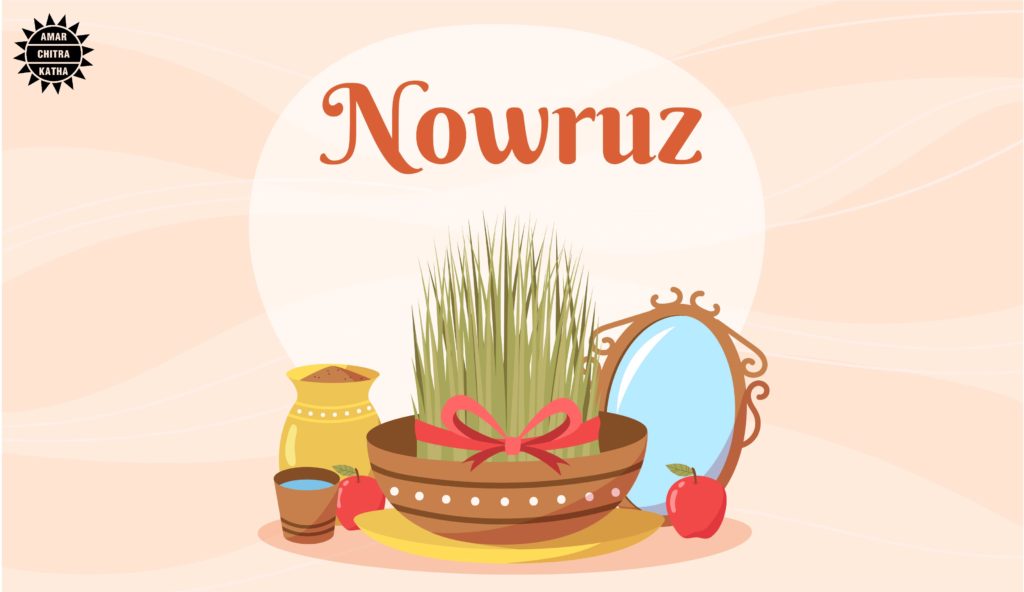 Celebrated by: Parsi community
Celebrated by: Parsi community
Indian Calendar Day: First Day of the Parsi Shahenshahi calendar
Gregorian Calendar Date: Late July or Early August
Other Significance: This day technically also marks spring equinox, according to the Persian calendar. However, since the Shahenshahi calendar does not account for leap days, this day has shifted about 200 days away from the original Nowruz of springtime.
Celebrations: The Parsi community in India celebrates this festival by cleaning and decorating their homes with flowers and rangolis, and inviting friends and family to celebrate with them. People also visit the Fire Temple and conduct a prayer called Jashan to thank the Lord and ask for prosperity in the new year. Dishes like Pulav, Sali Boti, Sweet Ravo, etc. are traditionally consumed on this day. Parsis also believe in making philanthropic contributions on this day.
Celebrated in: West Bengal, Tripura
Indian Calendar Day: First day of the Bengali calendar i.e. beginning of Boishakh month
Gregorian Calendar Date: 14th or 15th April
Other Names: Nobo Borsho
Other Significance: The festival of Haal Khata also falls on this day, on which Bengali traders and businessmen settle the year’s accounts and start a new ledger for the new year.
Celebrations: People start the new year by cleaning and decorating their houses and visiting family and friends to share meals. Bengali people usually eat Panta Bhaat, a rice dish eaten with the Hilsa fish. Men, as well as women, wear traditional red and white attire. People also attend rural fairs and processions to mark this special day.
Celebrated in: Gujarat
Indian Calendar Day: Shukla Paksha Pratipada in Kartik month of the Hindu calendar i.e. the day after Diwali
Gregorian Calendar Date: October or November
Other Names: Varsha Pratipada, Padwa
Other Significance: Bestu Varas also coincides with Govardhan Puja, during which people worship Lord Krishna and Balipratipada, which honours King Bali.
Celebrations: Gujarati businessmen close their account books on this day and start new ledgers for the new year – a ritual called Chopda. Goddess Lakshmi is also worshipped in Chopda Puja, to make the coming year prosperous and profitable. Apart from that, people also decorate and clean their homes and meet with friends and family to celebrate together. Children set off fireworks and seek blessings from their elders. Families also visit temples to pray for the coming year.
Celebrated by: Jewish community
Hebrew Calendar Day: First day of Tishrei, the seventh month of the ecclesiastical year of the Hebrew calendar
Gregorian Calendar Date: September
Other Names: Yom Teruah
Other Significance: Rosh Hashanah commemorates the creation of the world and marks the beginning of the Days of Awe, which is a 10 day period of introspection and repentance.
Observances: On Rosh Hashanah, Jews consume symbolic foods such as apples dipped in honey, to signify the sweet new year. Customs change depending on local practices, but other symbolic foods are dates, black-eyed peas, leeks, spinach, gourd, etc. Jewish people also use this time to reflect on the past year and pray at the synagogue.
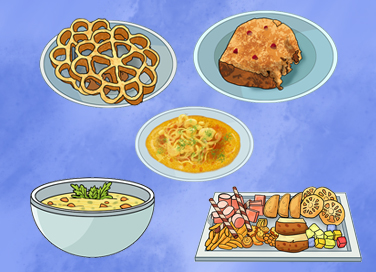
By Krithika Nair
While Indians unite in the festivals they celebrate, how they do it differs across the land. Every city, every village has its unique traditions, treats and rituals. While some have cultural significance, some just grow over time, getting passed on from generation to generation, like a precious family heirloom. As we gear up for the festive season, here are some lip-smacking Christmas special delicacies from all over the country that you could look forward to as you visit your friends and family to celebrate this joyous festival.

Kuswar is not a dish by itself but rather an assortment of sweets and savouries, prepared in advance and exchanged between friends and family, as part of the Christmas festivities among Goans and Mangaloreans. The tradition is said to have been inspired by the Portuguese concept of ‘consoada’, although there are other such traditions in India as well, such as the tradition of preparing and distributing ‘faral’ during Diwali in Maharashtra. Kuswar plates include many dishes, but most popularly feature delicacies such as bebinca, rose kokkisam, guliyo, dodol, neureyo, kidyo, tukdi, patheka, kormola, different types of laddu and much more.

Achappam is a flower-shaped fried rose cookie, popular in the states of Kerala and Tamil Nadu. The mildly sweet cookie is made out of rice batter and sesame seeds and is known for its light and crispy texture. Achappam is believed to be a result of the Dutch influence on the state’s cuisine during colonial times. The cookie gets its name from its peculiar shape – ‘ach’ meaning mould, and ‘appam’ meaning a dish cooked using flour or batter.
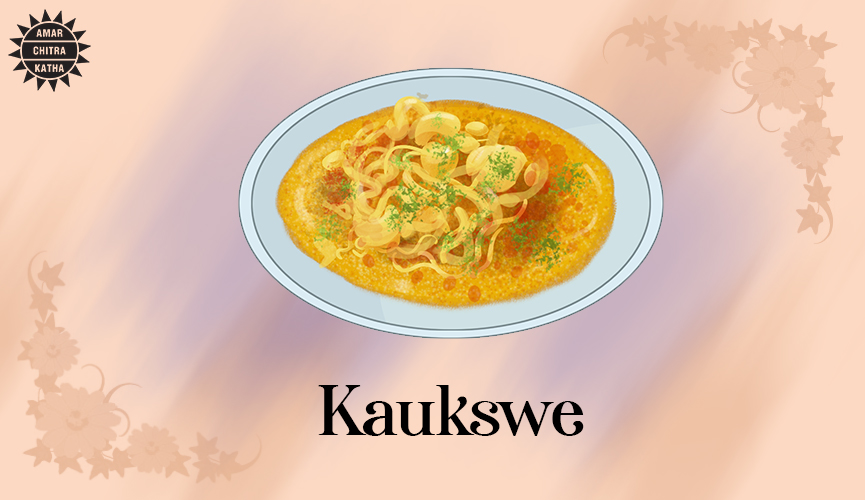
The north-eastern Christmas feast includes a lot of non-vegetarian dishes. Kaukswe is one of the most popular Christmas dishes in Mizoram. It is an inspired take on the Burmese Kaukswe, a mild curry which is eaten along with noodles. The dish is a medley of different Indian spices cooked in a broth of coconut milk, giving it a characteristic yellow colour. The dish is garnished with coriander and lime. There are many variations in the preparation of the dish, although the version containing eggs and chicken seems to be the most popular.
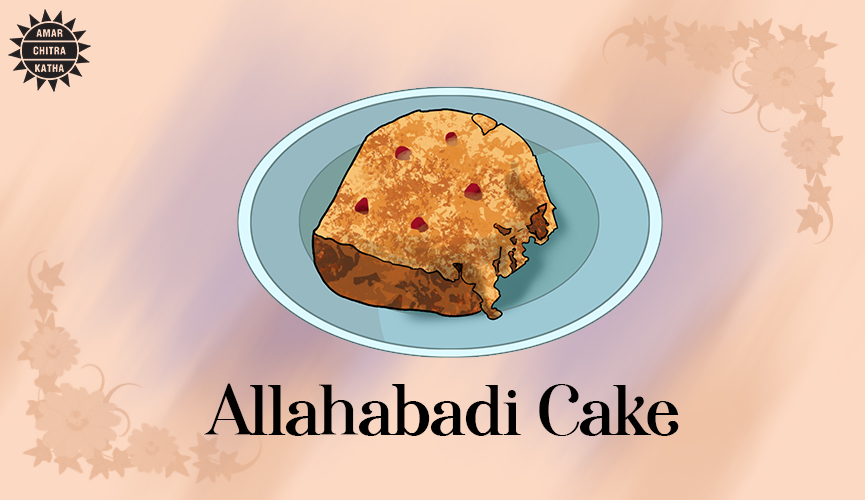
Allahabadi cake is a kind of Indian fruit cake that was named after the city it originated in. The characteristic feature of this cake is the presence of interesting ingredients like ginger, fennel and even ‘petha’ in its preparation, which makes it uniquely Indian. The fruits and nuts used in the preparation of the cake are often soaked in rum to pack a punch.
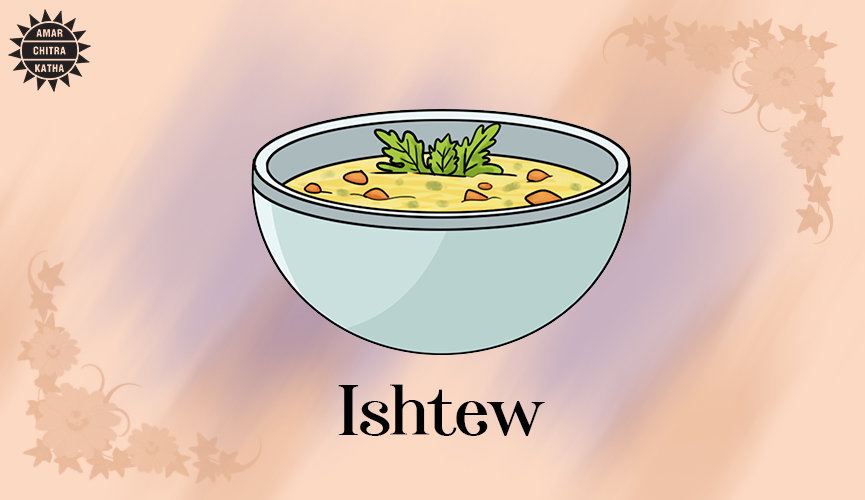
Ishtew is an Indian stew preparation made with vegetables cooked in coconut milk gravy. This dish too has popular non-vegetarian variations. Most popularly, ishtew is eaten alongside steaming appams on Christmas mornings in Kerala. The dish is quite a deviation from the typically spicy cuisine of South India, perhaps as an alternative to the other dishes that join the table on Christmas feasts.
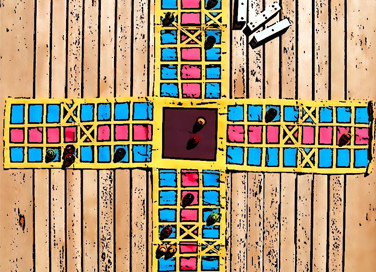
By Kayva Gokhale
Ever since the COVID-19 pandemic forced the entire world inside their homes, indoor games have become a more popular method of passing time. While families everywhere indulge in games of charades and cards, let’s take a look at some little-known ancient Indian games that were the predecessors of board games like Ludo, Snakes and Ladders, Chess and more.
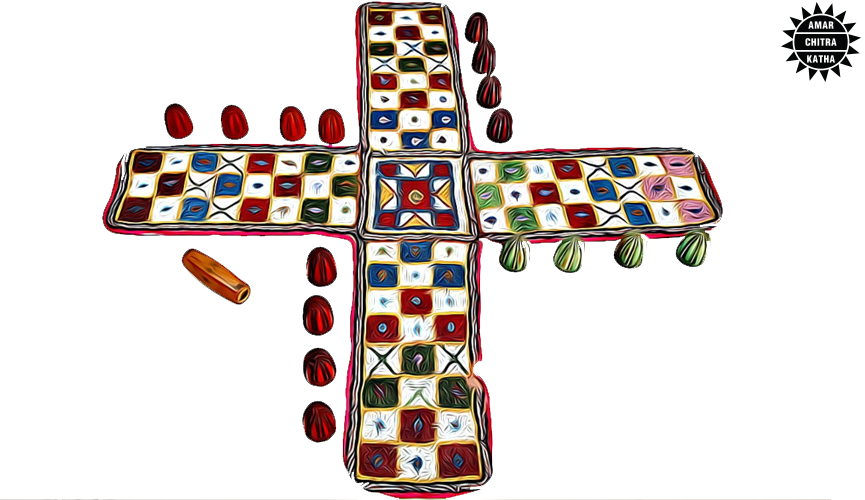
Believed to be the predecessor of the modern-day board game Ludo, Pachisi, was a cross and circle board game popularly found in ancient Indian texts. The game was played on a board shaped like a cross. Each player would throw six or seven cowrie shells (used as dice) and move pieces on the board until someone got all their pieces in the finish zone. The word Pachisi is believed to have been derived from ‘Pacchis’ meaning ‘twenty-five’ i.e. the largest score that could be thrown with cowrie shells. This game was so well-loved that emperors like Akbar would routinely play life-sized versions of the game, dividing the court itself into a large Pachisi board, with palace staff taking the place of the coloured pieces.
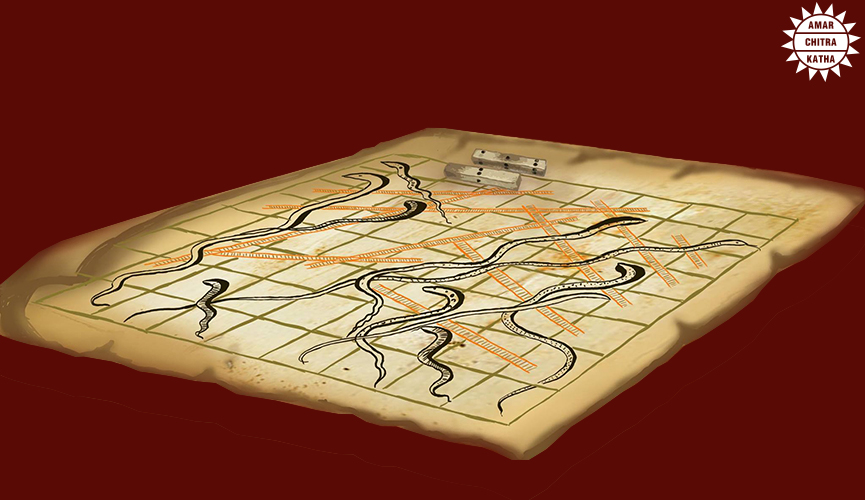
Also called Mokshapat, Moksha Patamu, was an ancient Indian game that is believed to have been invented by Swami Gyandev in the 13th century AD. However, certain sources also suggest that it existed long before that time and was played as early as the 2nd century BCE. This game, which became the blueprint for the modern-day game of Snakes and Ladders, was originally intended as a moral lesson for children, along with being a mode of entertainment.
In this game, players would encounter ladders on the squares representing good deeds and virtues, which would take them closer to 100, which symbolised ‘moksha’ or salvation – the objective of the game. However, the squares representing bad deeds or vices would be marked by snakes that would take players to lower levels. To emphasise the difficulty one faces in attaining salvation, Moksha Patamu would contain more snakes than ladders – a rule that, along with the moral symbolism of the game, was lost when the game was popularised as Snakes and Ladders in colonial times.
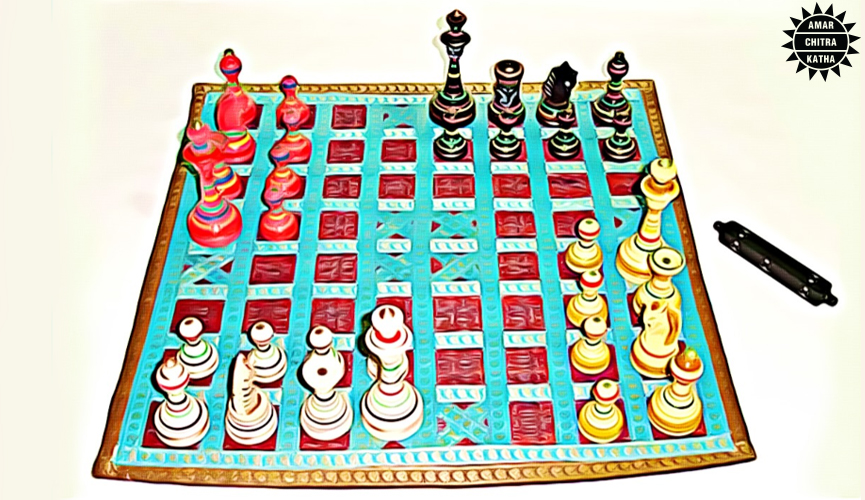
Chaturanga, or Catur, was an ancient Indian strategy game that evolved into the modern-day game of chess. Named after the ‘chaturanga’ or ‘four-limbs’ of the army i.e. infantry, cavalry, elephantry and chariotry, this game has its origins in the Gupta Empire, with references dating to the 6th century CE. However, many historians opine that the game existed, albeit in varying forms, far before that period. Like the modern-day version, Chaturanga was also played on an uncheckered eight-by-eight board with moving pieces representing various parts of an army, with the objective being to checkmate the opponent’s King.
Also called Ashta Chamma, Chowka Bhara was a two or four-player game that was played in ancient India to hone the mathematical skill of young children. The game was normally played on a five-by-five board, with players throwing four cowrie shells to determine how many moves their pieces would make. The objective of the game was to strategically ensure that all of a player’s pieces or pawns are taken to the centre square. One of the oldest board games of India, Chowka Bhara has been mentioned in Indian epics like the Mahabharata. It also appears to be one of the most complex games – involving elements of strategy as well as chance. While there is no modern equivalent of this game, it is still played in certain parts of India today.


Operating a submarine is both an art and a science. While a submarine is a potent ‘force multiplier’, it operates in the underwater medium that is constantly rife with danger. Only the most courageous, skilled and disciplined humans can thrive in a confined steel tube submerged below the waves for days on end. The Indian Navy holds the proud distinction of having developed a very competent and professional submarine arm in the last 50 years.

In 1967 INS Kalvari, a Russian ‘Foxtrot’ class submarine was commissioned. Between 1967 and 1974, seven more submarines were commissioned from Russia. These would be in the Kalvari class and Vela class.
India’s first submarine base, INS Virbahu, was commissioned in Visakhapatnam in 1971. Another submarine base, INS Vajrabahu, was commissioned at Mumbai in 1996. Because submarine warfare requires a lot of technical know-how, the Indian Navy trains and produces world-class submariners. The first Submarine Training establishment was INS Satavahana, also in Visakhapatnam.

Between 1986 and 2000, the Indian Navy acquired eight Sindughosh Class or Kilo Class submarines. These are extremely silent and highly automated boats with advanced weapons, including missiles.

The Shishumar Class of submarines is of deep significance to India’s maritime history. Two of the four boats were built in Germany and commissioned in 1986. The other two were built in Mazagon Docks in Mumbai, India and commissioned in 1992 and 1994, respectively. These were the first two submarines built in India.

Continuing the Make in India story, in the last decade, the Mazagon Docks started building Scorpene-Class submarines designed in France. Of the five ships, three were commissioned between 2017 and 2021, with one under trials and another in construction.

Between 1988 and 1991, India operated INS Chakra, a nuclear attack submarine, leased from Russia for three years. This was the first nuclear submarine to operate under the Indian naval ensign. Another nuclear attack submarine, also named INS Chakra, was leased from the Russians in 2012 for ten years. This submarine is still in operation.

INS Arihant, the first nuclear powered ballistic missile submarine to be built in India, was commissioned in 2016. India became the first country outside of the five permanent members of the UN Security Council to build a nuclear submarine.
Read more about the history of the Indian Navy in Amar Chitra Katha’s Naval Journey of India book series!
